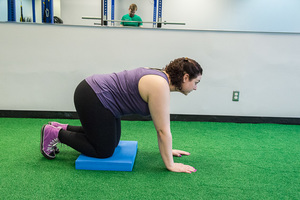There is a lot of talk about how pregnant women should take it easy before, after, and during pregnancy. Some professionals even advocate bed rest and very minimal levels of activity. I am not a medical professional but I am a strength coach. That being said, I have changed many clients’ workout programs around their pregnancy to allow for them to continue to train hard, make gains and get results. Clients have experienced a quicker recovery time post-pregnancy and were able to get back to pre-pregnancy weight faster because they kept exercising throughout their pregnancy. Now this is not to say you can go wild and do high volume olympic lifting, or compete in strongman right before giving birth. There are some stipulations during the second and third trimester that should be considered and some specific exercises that will help you along the way.
Your body goes through certain hormonal changes while pregnant. One of these changes is the release of extra relaxin and oxytocin. The increase in these hormones provide joints with more laxity, for good purpose. During the the second trimester this becomes something to consider. The modifications that should be made to your program are to change to positions of more stability, namely the squat to the lunge. The lunge or split leg squat provides the body with more stability so the expectant mother is less likely to end up sustaining lower body injury; keep in mind stability of the pelvis and core musculature is paramount for this exercise to be effective. The next stipulation is eliminating supine exercises from the program. Supine exercises (on your back) can cause blood pressure changes. Decreases in blood pressure can make the mother become light headed and faint. Overhead movements can also cause blood pressure to get too high, however overhead movements should be addressed on a case by case basis. Load stipulations should be considered starting in the middle of the second trimester, these considerations are also for blood pressure control. It has also been shown that vigorous exercise can cause growth restriction of the uterus. Switching to a higher rep scheme sticking more to the 8-12 rep range and rarely working to failure, if at all, is advised starting in the second trimester.
Control of the abdominal musculature is important during this process. Expansion and distention of the abdominal wall takes place and we want to keep the muscles in that area functioning well for a faster recovery. A few core exercises should be included in your program to help keep everything in check and avoid back pain during the process. The birddog, the shelf lift and some prone breathing strategies, as well as planking and single sided carries, are great ways to train while expecting.
Birddog:
If you read last week’s article the birddog is basically the prone version of the dead bug. Since supine exercises become contraindicated during the middle of the second trimester this is a great alternative for core control. You start on hand and knees keeping your neck in a neutral position looking at the floor you will lift one leg and extend it backward to hip level, but not above, flexing your glute as you do this. You will then push the same side arm into the ground and lift the opposing arm fully extended to be in line with your ear. Hold this position for 10 seconds and complete 5 reps on each side for 2 sets daily.



Shelf Lift:

A very easy, not so well known lift. You start with no weight and lift your arms overhead like you are putting a plate on a shelf you can’t quite reach. You will hold your arms there for about 30 seconds. Try 3 sets in a row, 2 times a day. Remember, there is not a real shelf, so keep your heels down. If you feel tightness right below your belly button that extends out to each hip at the end of the 30 seconds you are doing it right. Many of my clients do this in the shower every morning. You can always add a light load to this exercise like a 5 or 10lb plate, as you get better at it.
Breathing for Better Core Control:
A lot of us have breathing issues and don’t use the diaphragm to its full potential. The diaphragm is a powerful muscle that, if trained, can do a lot to stabilize the relationship between the hips and ribs, which from the last article is our definition of the core. The easiest position to train this through the entire pregnancy is to be on hands and knees. Again, making sure your spine is aligned and neutral. You will begin by breathing into your ribs and expanding them outward. To aid you in this, ask a friend to push in on the bottom of your ribs while you breathe in. After expanding the ribs, transfer the breath to push the abdomen out, think pushing a big Texas belt buckle down and way. Do 8-10 breaths at a time and hold them briefly once your belly is full. Breathe in through the nose and out through the mouth like you are breathing out of a straw. If you feel any light-headedness, stop.
These exercises help just as much pre-pregnancy as they do post. Know that there are really no contraindications post pregnancy, though those hormones can still be lingering, so be cautious with squats. Post pregnancy, it is okay to do supine exercises (on your back). Remember your gym life is not over because you are pregnant. I recommend seeing a health care provider that is willing to work with you to keep you exercising throughout your pregnancy. If there are any irregular pains, bleeding, swelling, dizziness or headache, stop exercise and consult a trusted medical professional.



